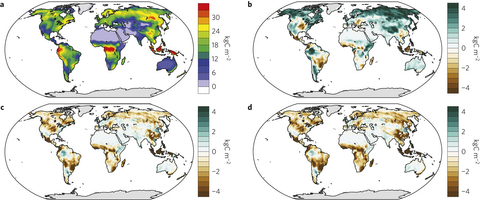植物或无法对抗全球变暖--有限的营养物质让植物生长速度变慢


植物是人类对抗气候变化的最后堡垒之一。它们会吸入二氧化碳气体从而生长得更快,并且随着人类不断制造温室气体,植物也会吸入更多的温室气体。然而一项新的研究发现,有限的营养物质或许让植物的生长速度无法像科学家想象的那样迅速,从而导致到2100年,全球变暖会比一些气候模型所预测得更为严重。
植物的茁壮成长需要不同的营养物质,例如氮被用来合成吸收光线的色素叶绿素,而磷则用来合成蛋白质。
农民在肥料中提供了这些营养物质,但是在自然界,植物必须自己找到它们的来源。
新的氮来自于空气——空气中有78%的体积是氮,但它们几乎全部以氮气的形式存在。植物并不能将氮气分解,因此它们只好依靠土壤中的细菌为其完成这项使命。一些植物——主要是豆科植物——在它们的根系中进化出了结节,用于储存它们的细菌。而新的磷则来自于风化的岩石,或者有时候从沙漠吹来的砂砾。
然而,这两种重要的营养物质在全球气候模型中很难被作出充分的解释。在政府间气候变化专门委员会(IPCC)最近用来在大多数报告中预测未来全球变暖的11个模型中,只有两个模型考虑到有限的氮对植物生长造成的影响;而没有一个模型考虑过磷,尽管2014年发表的一篇论文随后指出了这一疏漏。
因此美国科罗拉多州博尔德市国家大气研究中心生物地球化学家William Wieder和同事,着眼于分析在不同的模型中对于新植物的生长所进行的预测,并且估算了满足这些预测将需要耗费多少氮和磷。研究人员还研究了在天然来源中有多少额外的氮和磷是实际可用的。结果他们发现,如果不相应地校正模型,将没有足够的氮和磷能够满足预测。
研究人员在4月20日的《Nature Geoscience》杂志网络版上报告说,与IPCC的数据相比,考虑了氮和磷后的年度全球碳储存平均预测值减少了25%。到2100年,这样一种戏剧性的减少将使土地从吸收碳变为泵出碳——随着土壤微生物的呼吸作用(它们会释放出二氧化碳气体),全球温度将变得更高。这意味着随着土地开始放大人类活动导致的气候变暖而非减缓这种趋势,地球将变得更热。
然而,这里依然存在各种各样的未知数。例如,土壤中的细菌在分解死亡的植物后会释放出氮和磷,因此这些微生物能够增加可以获得的氮和磷的总量。
加利福尼亚州帕洛阿尔托市卡内基研究所生态学家Chris Field表示,这篇论文是“扎实的、令人兴奋的研究”。他强调,不同的模型可能着眼于能够对未来植物生长造成影响的不同因素。
佛洛斯特堡马里兰大学环境科学中心生物地球化学家Eric Davidson认为,研究人员需要进行更多的野外研究,从而搞清营养物质状况如何影响森林的生长。Davidson说:“这是很难做的,同时也是很昂贵的,但这是我们能够为这些模型获得更好参数的唯一方法。”(来源:中国科学报 赵熙熙)
Future productivity and carbon storage limited by terrestrial nutrient availability
Abstract The size of the terrestrial sink remains uncertain. This uncertainty presents a challenge for projecting future climate–carbon cycle feedbacks. Terrestrial carbon storage is dependent on the availability of nitrogen for plant growth, and nitrogen limitation is increasingly included in global models. Widespread phosphorus limitation in terrestrial ecosystems may also strongly regulate the global carbon cycle, but explicit considerations of phosphorus limitation in global models are uncommon16. Here we use global state-of-the-art coupled carbon–climate model projections of terrestrial net primary productivity and carbon storage from 1860–2100; estimates of annual new nutrient inputs from deposition, nitrogen fixation, and weathering; and estimates of carbon allocation and stoichiometry to evaluate how simulated CO2 fertilization effects could be constrained by nutrient availability. We find that the nutrients required for the projected increases in net primary productivity greatly exceed estimated nutrient supply rates, suggesting that projected productivity increases may be unrealistically high. Accounting for nitrogen and nitrogen–phosphorus limitation lowers projected end-of-century estimates of net primary productivity by 19% and 25%, respectively, and turns the land surface into a net source of CO2 by 2100. We conclude that potential effects of nutrient limitation must be considered in estimates of the terrestrial carbon sink strength through the twenty-first century.
原文链接:http://www.nature.com/ngeo/journal/vaop/ncurrent/full/ngeo2413.html

